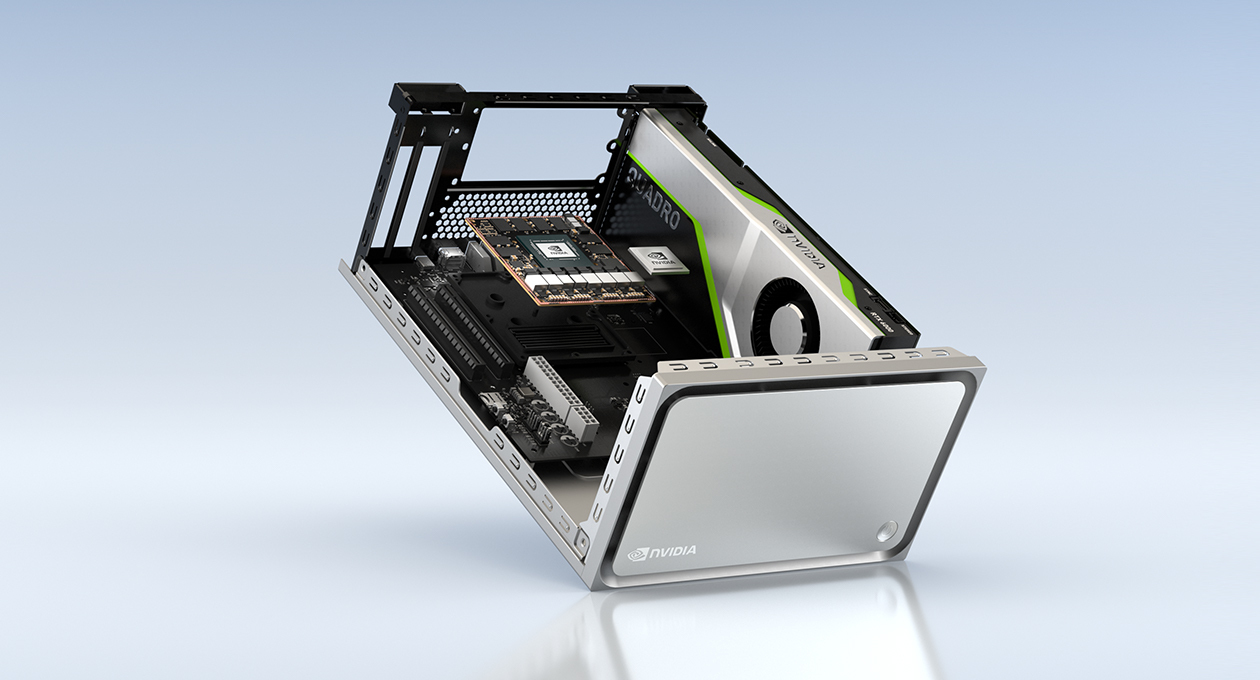Carestream Health, a leading maker of medical imaging systems, is investigating the use of NVIDIA Clara AGX — an embedded AI platform for medical devices — in the development of AI-powered features on single-frame and streaming x-ray applications.
Startups around the world, too, are adopting Clara AGX for AI solutions in medical imaging, surgery and electron microscopy. Among them is Boston-based Activ Surgical, which recently received FDA clearance for a hardware imaging module to deliver real-time AI insights to the operating room.
Now in general availability, the NVIDIA Clara AGX developer kit advances the development of software-defined instruments, such as microscopes, ultrasounds and endoscopes.
This emerging generation of medical devices is equipped with dozens of real-time AI applications providing support at every step of the clinical experience — from automating patient set-up for scans and improving image quality to analyzing data streams and delivering critical insights to care providers.
NVIDIA Clara AGX is accelerating the development of these new medical instruments by providing a universal platform that can deliver high-bandwidth signal processing, accelerated computing reconstruction, AI processing and advanced 3D visualization.
Helping Clinicians Sense in Real Time
Medical instruments like endoscopes and surgical robots are mounted with cameras, sending a live video feed to the clinicians operating the devices. Capturing these streams and applying computer vision AI to the video content can give medical professionals tools to improve patient care and bolster the capabilities of hospitals that lack adequate medical imaging resources.
Architected with NVIDIA Jetson AGX Xavier, an NVIDIA RTX 6000 GPU and the NVIDIA Mellanox ConnectX-6 SmartNIC, the Clara AGX developer kit comes with an SDK that makes it easy for developers to get up and running with real-time system software, libraries for input/output and video pipelining, the NVIDIA Mellanox Rivermax SDK for data streaming, and reference applications to create AI models for ultrasound and endoscopy.
Built into the platform is the NVIDIA EGX stack for cloud-native containerized software and microservices, including NVIDIA Fleet Command to securely deploy fleets of devices in hospitals, which together transform everyday sensors into smart sensors.
These smart sensors will be software-defined, meaning they can be regularly updated with AI algorithms as they improve — an essential capability to continuously connect research breakthroughs with the day-to-day practice of medicine.
Enabling Intelligent Instruments
Carestream Health is creating smart X-ray rooms that will include AI-powered features for an enhanced imaging workflow and faster, more efficient exams. The devices include automated positioning and exposure settings for similar exam types, which helps improve the consistency of X-ray images, boosting diagnostic confidence.
And Activ Surgical, a member of the NVIDIA Inception startup accelerator program, is using NVIDIA GPU-accelerated AI to deliver real-time surgical guidance. The company’s newly FDA-cleared ActivSight module will power its ActivINSIGHT product, which will provide surgeons with previously unavailable visual overlays, including blood flow and perfusion without the need for the injection of dyes.
Carestream Health and Activ Surgical are just two of the pioneering companies worldwide using NVIDIA AGX systems to power intelligent medical devices. Others include:
- AJA Video Systems, based in California’s Gold Country, develops professional video and audio PCIe cards for high-bandwidth streaming. When combined with the NVIDIA Clara AGX developer kit, which includes two PCIe slots and high-speed network ports, the company’s cards can be used for endoscopy and surgical visualization applications.
- Kaliber Labs, an NVIDIA Inception member, is building real-time AI-powered software solutions to support surgeons performing arthroscopic and minimally invasive procedures. Kaliber uses NVIDIA Clara AGX to deploy its surgical software suite, which equips surgeons with a first-of-its-kind contextualized and personalized surgical toolkit to help surgeons perform at the highest level and reduce surgical variability.
- KAYA Instruments, an NVIDIA Inception member, develops computer vision products that can be used with imaging devices, including electron microscopes, ultrasound machines and MRI equipment. The Israel-based company’s video acquisition cards and cameras transfer medical imaging content to NVIDIA GPUs for real-time processing and AI-accelerated analysis.
- Subtle Medical, an NVIDIA Inception member, has deployed FDA-cleared and CE-marked deep-learning powered image enhancement software solutions for PET and MRI protocols. The company will leverage NVIDIA Clara AGX for SubtleIR, an AI-powered software under development that improves the speed and quality of interventional imaging procedures.
- Theator, an NVIDIA Inception member, will use NVIDIA Clara AGX to develop its surgical analytics platform. The Palo Alto-based startup is developing edge GPU-accelerated AI systems to annotate operation room footage, allowing surgeons to conduct post-surgery reviews where they can compare parts of a procedure with previous identical procedures.
- us4us, a Poland-based maker of ultrasound research systems, is using NVIDIA AGX systems for a portable ultrasound platform that will support real-time digital beamforming — a compute-intensive technique essential to capturing quality ultrasound images. The software-defined system uses embedded GPU modules so medical researchers can develop and deploy custom AI models for image processing during ultrasound scans.
Learn more about Clara AGX for AI-powered medical devices and instruments in the GTC talk, “Using Ethernet to Stream High-Throughput, Low-Latency Medical Sensor Data.” The NVIDIA GPU Technology Conference is free to register. The healthcare track includes 16 live webinars, 18 special events and over 100 recorded sessions.
Registration isn’t required to watch NVIDIA CEO Jensen Huang’s keynote address.
Subscribe to NVIDIA healthcare news, and follow NVIDIA Healthcare on Twitter.
